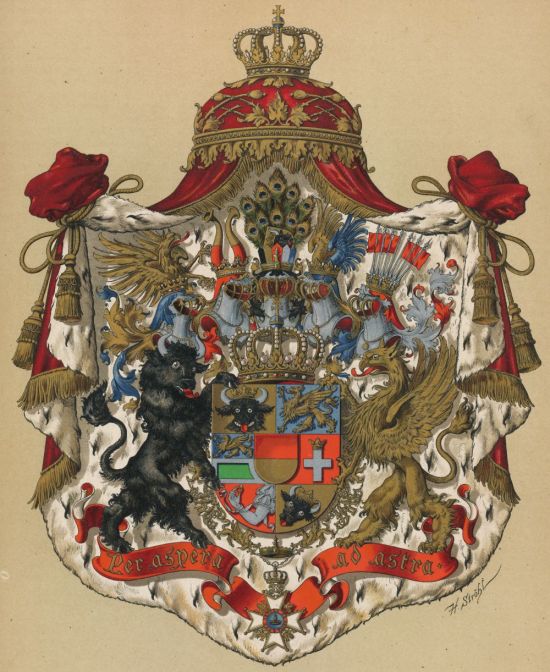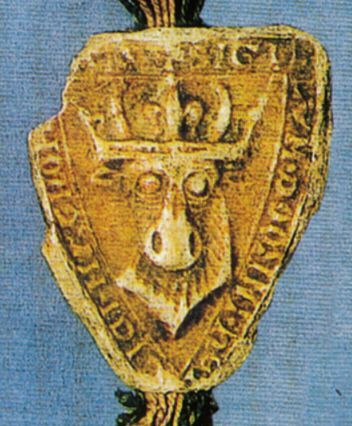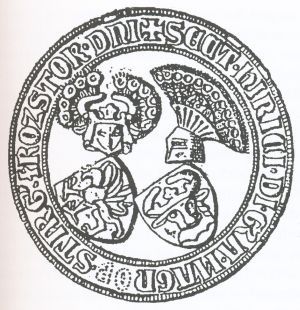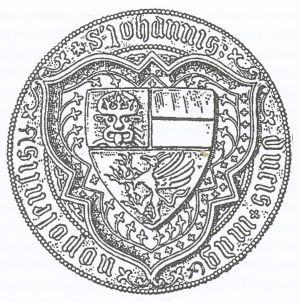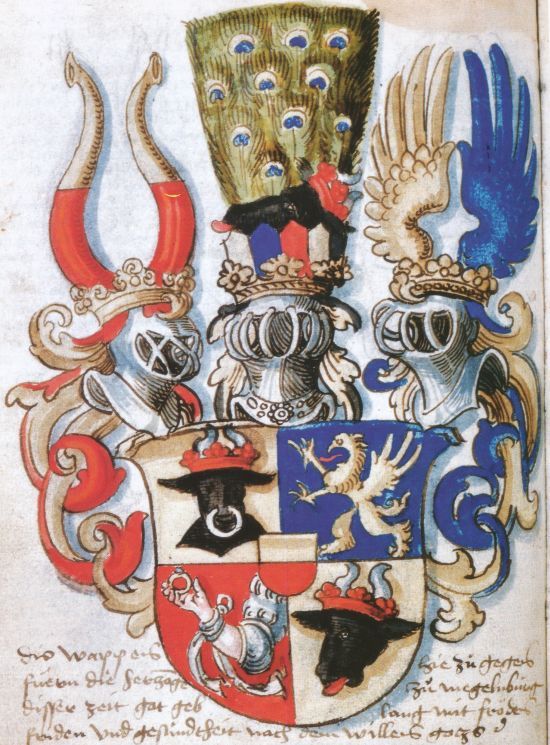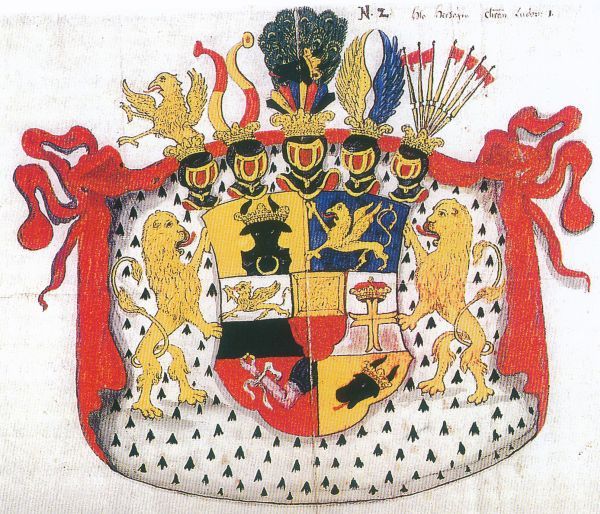Mecklenburg: Difference between revisions
Knorrepoes (talk | contribs) m (Text replacement - "{{de1}}" to "{{de}}") |
Knorrepoes (talk | contribs) m (Text replacement - "{{media1}}" to "{{media}}") |
||
| Line 62: | Line 62: | ||
{{de}} | {{de}} | ||
{{ | {{media}} | ||
[[Literature]] : Hupp, 1897; Schutt 2002. | [[Literature]] : Hupp, 1897; Schutt 2002. | ||
[[Category:German States]] | [[Category:German States]] | ||
Revision as of 07:42, 4 August 2023
MECKLENBURG
| German | blazon wanted |
| English | blazon wanted |
Origin/meaning
Mecklenburg is an area in the north-east of present Germany. It was a Duchy from the 13th century until 1701.
The area of Mecklenburg was settled by Slavic tribes in the 7th century. During the 9th-11th century the was under influence of the Germanic eastward colonisation. In 1160 Prince Niklot, who resided in the castle of Mecklenburg, accepted Heinrich der Löwen (Henry the Lion), Duke of Saxony and Bavaria as his overlord. Duke Heinrich made the newly founded city of Schwerin the capital of the region and founded the County of Schwerin, and gave Pribislaw, the son of Niklot most of the area in loan. Pribislaw became thus the first Prince of Mecklenburg until 1178.
At the end of the 12th century the Princes of Mecklenburg and their cousins, the Princes of Rostock, became vassals of the Danish Kings. The oldest seals of the Princes of Mecklenburg date from around 1200 and show a griffin. The meaning of the griffin, or a possible relation with neighbouring Pommern is not known.
Around 1200 a bull's head appears as a typical symbol on coins issued in Mecklenburg. The bull's head was first used on seals by Nikolaus of Mecklenburg (1219-1255). His cousin, Heinrich Borwin II von Rostock, still used a griffin on his seals. The meaning of the bull's head is also not clear, most likely it simply indicates strength. In 1227 Heinrich Borwin I of Mecklenburg died in the battle of Bornhöved.
The territory became again a loan of Saxony and was divided into four separate territories; the Lordship of Mecklenburg, the Lordship of Rostock, the Lordship of Werle and the Lordship of Parchim-Richenberg. The dioceses of Schwerin and Ratzeburg as well as the County of Schwerin were surrounded or bordered the different former Mecklenburg territories, see map below.
Of the four new territories, Rostock kept the girffin, the other three all used the bull's head as their symbol. To distinguish the different arms, the Lords of Mecklenburg started to use the bull's head with a piece of skin of the neck still attached, as can be seen on the seal of Heinrich I, Lord of Mecklenburg (ruled 1264-1302) below.
| Seal of Heinrich I, Lord of Mecklenburg (from Schütt, 2002) |
Heinrich II of Mecklenburg (ruled until 1329) slowly increased his territory. First with the estate of Stargard, which had no arms, thus no change was made in the seals of Mecklenburg. Between 1314 and 1323 he acquired the Lordship of Rostock and he combined the arms of Mecklenburg and Rostock in his seal, see image below.
| Seal of Heinrich II, Lord of Mecklenburg (from Schütt, 2002) |
During the 14th century the Lords of Mecklenburg became direct vassals of the German Emperor and were promoted to the rank of Duke. In 1352 the Duchy was divided into the Duchy of Mecklenburg-Schwerin and the Duchy of Mecklenburg-Stargard. In 1358 Albrecht II of Mecklenburg-Schwerin acquired the County of Schwerin and added the arms of the county (a divided shield of gold and red) to his arms. Initially the seal showed the three arms separately, his sons combined the three arms into one single shield, see below.
| Seal of Johann IV, Duke of Mecklenburg-Schwerin from 1390. (from Schütt, 2002) |
Besides the combined arms, the Dukes of Mecklenburg also used a small shield with the bull's head on smaller seals. The colours of the arms are also used from the late 14th century. During the 15th century the Dukes of Mecklenburg gradually acquired the Lordship/Principality of Werle and the Duchy of Mecklenburg-Stargard, which meant a further division of the arms. For Werle the bull's head with extended tongue, but without the skin in the neck was taken, but for Stargard no arms or symbol existed. For unknown reasons, a woman's arm with a ring was chosen as a symbol to represent Stargard in the new arms. During the next decades the basic design of the arms remained the same, but some of the smaller details were changed. The open mouth of the original Mecklenburg bull was changed into a nose-ring and the bull's head of Werle was rotated 45 degrees, based on an old seal. This resulted in the arms as shown below.
| The arms of Mecklenburg as shown in 1524. (from Schütt, 2002) |
The arms in the Wapen- en Vlaggenboek van Gerrit Hesman (1708) |
After the Thirty-years war the Dukes of Mecklenburg lost some territory to Sweden, but received as compensation the Principalities (and former dioceses) of Schwerin and Ratzeburg. The arms of these territories needed to be added to the arms, which created an even more complicated shield. The final design took a long time to complete and fianlly resulted in the arms as shown on top of the page.
The initial design from 1658 is shown below. The different fields represent :
1 : the bull of the Duchy of Mecklenburg itself,
2 : the griffin of the County of Rostock,
3 : the griffin of the Principality of Schwerin,
4 : the cross of the Principality of Ratzeburg,
5 : the arm of the County of Stargard,
6 : the bull of the Principality of Werle,
the escutcheon with the arms of the County of Schwerin.
| The design from 1658 (from Schütt, 2002) |
In 1701 the Duchy was divided in Mecklenburg-Strelitz, and Mecklenburg-Schwerin, but both used the same arms as above until 1918.
This page is part of the German heraldry portal Deutsche Wappensammlung |
Heraldry of the World |
|
German heraldry:
|
Selected collector's items from Germany:
|
Contact and Support
Partners:
Your logo here ?
Contact us
© since 1995, Heraldry of the World, Ralf Hartemink 
Index of the site
Literature : Hupp, 1897; Schutt 2002.
